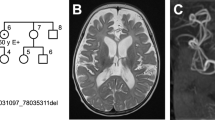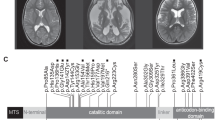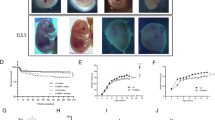Abstract
Menkes disease is an X-linked disorder of copper metabolism caused by mutations in the ATP7A gene. Whereas most of the patients exhibit a severe classical form, about 9% of the patients exhibit a milder form of Menkes disease. The mildest form is called occipital horn syndrome (OHS). Mutations in the ATP7A gene can be identified in 95–98% of the Menkes disease patients by standard screening techniques. Investigation of RNA isolated from the fibroblasts of eleven patients with no identified mutations was performed, and revealed inclusion of new pseudo-exons into the ATP7A mRNA from three unrelated patients: two patients with OHS and one patient with classical Menkes disease. The pseudo-exons were inserted between exons 10 and 11, between exons 16 and 17 and between exons 14 and 15 in the three patients, as a result of deep intronic mutations. This is the first time the activation of pseudo-exons is demonstrated in the ATP7A gene, and it demonstrates the usefulness of RNA analysis, in terms of revealing disease-causing mutations in noncoding regions. The fact that three different mutations cause disease by the activation of pseudo-exon inclusion also indicates that in Menkes disease this is an important mechanism, which has hitherto been overlooked.
Similar content being viewed by others

Log in or create a free account to read this content
Gain free access to this article, as well as selected content from this journal and more on nature.com
or
References
Menkes JH, Alter M, Steigleder GK, Weakley DR, Sung JH : A sex-linked recessive disorder with retardation of growth, peculiar hair and focal cerebral and cerebellar degeneration. Pediatrics 1962; 29: 764–779.
Kodama H, Murata Y : Molecular genetics and pathophysiology of Menkes disease. Pediatr Int 1999; 41: 430–435.
Das S, Levinson B, Vulpe C, Whitney S, Gitschier J, Packman S : Similar splicing mutations of the Menkes/mottled copper-transporting ATPase gene in occipital horn syndrome and the blotchy mouse. Am J Hum Genet 1995; 56: 570–576.
Møller LB, Mogensen M, Horn N : Molecular diagnosis of Menkes disease: genotype-phenotype correlation. Biochimie 2009; 91: 1273–1277.
De Paepe A, Loeys B, Devrient K, Fryns JP : Occipital horn syndrome in a 2 year old boy. Clin Dysmorphol 1999; 8: 179–183.
Skjørringe T, Tümer Z, Møller LB : Splice site mutations in the ATP7A gene. PLoS One 2011; 6: e18599.
Møller LB, Hicks JD, Holmes CS et al: Diagnosis of copper transport disorders. Curr Protoc Hum Genet 2011; Chapter 17: Unit17.9.
Dierick HA, Ambrosini L, Spencer J, Glover TW, Mercer JFB : Molecular structure of the Menkes disease gene (ATP7A). Genomics 1995; 28: 462–469.
Desmet FO, Hamroun D, Lalande M, Collod-Beroud G, Claustres M, Béroud C : Human Splicing Finder: an online bioinformatics tool to predict splicing signals. Nuclei Acids Res 2009; 37: e67.
Mount SM : A catalogue of splice junction sequences. Nuclei Acids Res 1982; 10: 459–472.
Maquat LE : When cells stop making sense: effects of nonsense codons on RNA metabolism in vertebrate cells. RNA 1995; 1: 453–465.
Møller LB, Tümer Z, Lund C et al: Similar splicesite mutations of the ATP7A gene lead to different phenotypes: classical Menkes disease or occipital horn syndrome. Am J Hum Genet 2000; 66: 1211–1220.
Madsen EC, Morcos PA, Mendelsohn BA, Gitlin JD : In vivo correction of a Menkes disease model using antisense oligonucleotides. Proc Natl Acad SCi USA 2008; 105: 3909–3914.
Acknowledgements
We thank the Menkes families for participating in this investigation. Written informed consent is obtained from the relatives of the three patients. We would like to thank Gabriela Soares, Unidade Genética Médica, CGMJM, Praça Pedro Nunes, 88, 4099-028, Porto, Portugal for collaboration. We are also very grateful to Jette Rune Rasmussen for assistance with generating the figure and to Brage Storstein Andresen for critical review of this manuscript. The research leading to these results has received funding from the Lundbeck Foundation.
Author information
Authors and Affiliations
Corresponding author
Ethics declarations
Competing interests
The authors declare no conflict of interest.
Rights and permissions
About this article
Cite this article
Yasmeen, S., Lund, K., De Paepe, A. et al. Occipital horn syndrome and classical Menkes Syndrome caused by deep intronic mutations, leading to the activation of ATP7A pseudo-exon. Eur J Hum Genet 22, 517–521 (2014). https://doi.org/10.1038/ejhg.2013.191
Received:
Revised:
Accepted:
Published:
Issue date:
DOI: https://doi.org/10.1038/ejhg.2013.191
Keywords
This article is cited by
-
Missing heritability of Wilson disease: a search for the uncharacterized mutations
Mammalian Genome (2023)
-
Orthopaedic interventions in occipital horn syndrome: a rare case of mutation in ATP7A gene
Egyptian Journal of Medical Human Genetics (2022)
-
Deep intronic mutations and human disease
Human Genetics (2017)


